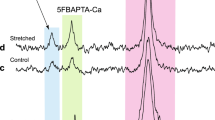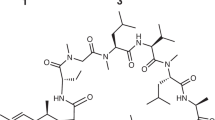Abstract
ALTHOUGH there is recent evidence1–4 that cell potassium is complexed, it is still generally believed that intercellular K+ is in free solution. Nuclear magnetic resonance (NMR) has already provided direct evidence that another cellular cation (Na+) is complexed5–8,20,21. When the same approach was used to study cell 39K, the first measurements barely detected an NMR signal from saturated aqueous KCl with the same instrumentation which measured Na+ at a concentration of 0.005 M. NMR sensitivity was limited primarily by the magnetic fields available from conventional electromagnets (13,000 gauss). The key to successful NMR measurement of 39K was the opportunity for the use, for a few days, of a superconductive magnet to generate a magnetic field of approximately 50,300 gauss. Besides increased sensitivity resulting from a higher resonant frequency, the superconductive magnet provided additional improvement in signal-to-noise ratio from prolonged averaging made possible by the high stability of the magnetic field. A further improvement in experimental technique was the use of pulsed NMR, which meant that relaxation time could be measured directly, thus eliminating some of the ambiguity inherent in the interpretation of steady state NMR data. A spin-echo NMR spectrometer (model PS60–AW, Nuclear Magnetic Resonance Specialties, Inc.) operating at 107 Hz was used, with a low noise preamplifier, and RC filtering of approximately 50 per cent or less of T2. Before each measurement, the magnetic field was adjusted for NMR resonance using the beat pattern of a saturated solution of K2CO3 (12 M K+). In spite of the improvements in instrumentation, the measurement of K+ in a living system would still not have been possible but for the use of a bacterium (H. halobium) with an extraordinarily high concentration of K+ (4–5 M) (ref. 9 and unpublished results of M. and B. Ginzburg).
This is a preview of subscription content, access via your institution
Access options
Subscribe to this journal
Receive 51 print issues and online access
$199.00 per year
only $3.90 per issue
Buy this article
- Purchase on Springer Link
- Instant access to full article PDF
Prices may be subject to local taxes which are calculated during checkout
Similar content being viewed by others
References
Damadian, R., Science, 165, 79 (1969).
Ling, G., and Cope, F. W., Science, 163, 1336 (1969).
Ling, G. N., and Ochsenfeld, M. M., Biophys. J., 5, 777 (1965).
Jones, A. W., and Karreman, G., Biophys. J., 9, 910 (1969).
Cope, F. W., Proc. US Nat. Acad. Sci., 54, 225 (1965).
Cope, F. W., J. Gen. Physiol., 50, 1353 (1967).
Cope, F. W., Bull. Math. Biophys., 29, 691 (1967).
Rotunno, C. A., Kowalewski, V., and Cereijido, M., Biochim. Biophys. Acta, 135, 170 (1967).
Larsen, H., in The Bacteria, 4 (edit. by Gunsalus, I. C., and Stanier, R. Y.) (Academic Press, New York, 1962).
Deverell, C., and Richards, R. E., Mol. Phys., 10, 551 (1967).
Hindman, J. C., J. Chem. Phys., 36, 1000 (1962).
Cope, F. W., Biophys. J., 9, 303 (1969).
Damadian, R., J. Bact., 95, 113 (1968).
Eisenstadt, M., and Friedman, H. L., J. Chem. Phys., 44, 1407 (1966).
Samoilov, O. Ya, in Structure of Aqueous Electrolyte Solutions and the Hydration of Ions (Consultants Bureau, New York, 1965).
Hazlewood, C. F., Nichols, B. L., and Chamberlain, N. F., Nature, 222, 747 (1969).
Cerbon, J., Biochim. Biophys. Acta, 88, 444 (1964).
Cerbon, J., Biochim. Biophys. Acta, 144, 1 (1967).
Kushner, D. J., Biotechn. Bioeng., 8, 237 (1966).
Czeisler, J. L., Fritz, O. G., and Swift, T. L., Biophys. J., 10, 260 (1969).
Cope, F. W., Biophys. J., 11 (in the press).
Author information
Authors and Affiliations
Rights and permissions
About this article
Cite this article
COPE, F., DAMADIAN, R. Cell Potassium by 39K Spin Echo Nuclear Magnetic Resonance. Nature 228, 76–77 (1970). https://doi.org/10.1038/228076a0
Received:
Revised:
Issue Date:
DOI: https://doi.org/10.1038/228076a0
This article is cited by
-
State of water in extremely halophilic bacteria: Freezing transitions ofHalobacterium halobium observed by differential scanning calorimetry
The Journal of Membrane Biology (1980)
-
The physical state of alkali ions in a Halobacterium: Some NMR results
Experientia (1977)
-
Pulsed nuclear magnetic resonance study of39K within Halobacteria
The Journal of Membrane Biology (1977)
Comments
By submitting a comment you agree to abide by our Terms and Community Guidelines. If you find something abusive or that does not comply with our terms or guidelines please flag it as inappropriate.



